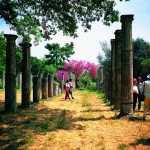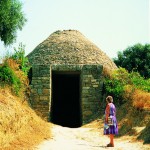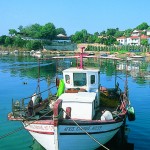
Olympia, Peloponnese
The Peloponnese has rightly been called the cradle of civilisation – it boasts many world-famous historical and archaeological sites such as Mystras, Olympia and the Corinth Canal.
Historians and fans of Ancient Greece might be interested to hear that there are many other good reasons for travelling to the Peloponnese, particularly in the southern area of Messinia, where there are several less famous historical sites which are fascinating, often completely free and off the main excursion circuit. With a bit of planning it is possible to visit many of these and enjoy the splendours of Greek history without the company of other day-trippers and excursion groups.
The modern town of Messini has little to recommend it but the nearby archaeological site of Ancient Messini rivals Olympia in size and scope. It has somehow been overlooked by the tour groups and has a magical atmosphere in a beautiful setting. It is located below the tiny village of Mavromati (this means ‘black eye’ and refers to the dark lichen growing around the small village spring) and spreads out panoramically beneath the village houses. It is one of the most significant ancient cities in terms of its size, structure and state of preservation and there is still much to be discovered. Along with the sanctuaries and public buildings it has imposing fortifications, dwellings and burial sites. It has the rare advantage of never having been destroyed or covered by later settlements. When I was last there a team of archaeologists was still excavating parts of the ruins. A car is needed to explore it properly (or a strong pair of legs) and lunch can be taken in the village taverna afterwards.

Nestor's Tomb, near Pylos
In 1939 the ruins of Nestor’s Palace were rediscovered by an American archaeologist. They lie close to the charming small town of Pylos . The Palace is one of the most important monuments of Mycenaean Greece, because it is the only Mycenaean Palace which is in such good condition. The palaces were built in the 13th century B.C. by King Nestor who took part in the Trojan War with ninety ships. King Nestor is portrayed as one of the most respected characters in the Homeric epics. The Palace ruins give a fascinating insight into the domestic life of Greek kings. Nestor’s bathroom is intact with the bath in place. Speculation has it that the small step next to the bath was to help the king get in and out of his bath as he got older. A set of stone tablets discovered at the site (written in the ancient hieroglyphs of ‘Linear B’) proved to be rather prosaic when translated- domestic lists and details of palace admin….
The whole area of Messinia is very well fortified which makes it a fascinating place for the ‘castle-lover’ to visit. At Koroni – near the pretty seaside village of Finikounda – the stunning castle is intriguing as many people still live inside the castle walls and worship at the Orthodox churches inside. At Methoni the castle is especially impressive as it juts out into the sea, and was a sign of the town’s early wealth and strength. It has elements of Byzantine, Frank and Venetian styles. The town of Pylos has 2 castles – the Neokastro (new castle) and the Paleokastro (old castle), both of which are worth a visit.
Sunvil has many accommodation options in this area, particularly around the village of Chrani, which makes the perfect base for exploring the area’s history, and also in Finikounda , Methoni and Pylos which are all close to the historical wonders of the area.
Janine Cording
Sunvil Holidays
Read about fly-drive holidays in Hidden Greece





